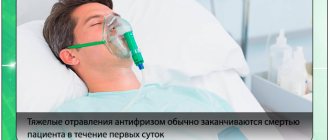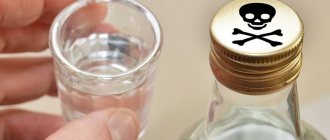Sulfur compounds are an intermediate or by-product of a number of industrial and natural processes. Their danger lies in the fact that they are capable of causing severe, sometimes progressive poisoning. Most often, sulfur dioxide is found in urban smog, which forms after frequent emissions from city-forming industrial enterprises.
Chronic sulfur poisoning is typical for workers in textile industry enterprises producing viscose, silk, and cellophane. Sulfur compounds are also used in the chemical industry, as well as in agriculture in the form of insecticides.
Contact with sulfur in any form can result in severe poisoning. A lethal dose for humans is 1 gram of carbon disulfide if ingested; if we talk about the concentration of sulfur in air masses, then 10 ml is sufficient.
Sulfur residues accumulate in the bulk of the kidneys and liver, and naturally do not leave their mark on these organs.
The presence of sulfur compounds in the air, in particular hydrogen sulfide, can be determined by the presence of the characteristic smell of rotten eggs. It is noteworthy that a concentration of the substance in air masses from 0.02 to 0.2 ml can cause poisoning, and 1.2 mgl can lead to death.
The effect of sulfur dioxide on the body
Typically, when E220 is consumed within the permissible limit, the preservative quickly oxidizes and is then excreted in the urine without causing significant damage to the body. But in some cases, especially when consumed above the norm, sulfur dioxide can cause significant harm to health.
One of the negative consequences of consuming E220 is that when it enters the stomach, this substance destroys vitamin B1, the lack of which is bad for human health. Also, sulfur dioxide can cause allergic reactions and even provoke the appearance of cancerous tumors.
People with heart failure should be careful when consuming foods containing this preservative. E220 is also contraindicated for use in people suffering from asthma, because an attack of suffocation caused by this dietary supplement can be fatal. Sulfur dioxide can also be dangerous for those who suffer from ulcers, gastritis or other gastrointestinal diseases, due to its ability to increase the acidity of gastric juice.
Gas protection
You can protect yourself from toxic sulfur anhydride using a gas mask. A respirator and safety glasses can be used, but only if the treatment area is small and a maximum of two tablets is used.
As a rule, two people carry out the processing. One controls the process, and the other processes the room. If the floor in the greenhouse is wooden, you cannot place a saber with a wick on it. A basin or other objects are usually used for this.
You cannot be distracted by food or drink liquids during the process. There should be no children or animals nearby. Immediately after setting fire, a person must leave the room; being among the smoke is extremely dangerous. If several checkers are set on fire, they should be lit in such order that the handler moves towards the exit and has time to get out before the smoke starts to flow.
Symptoms of sulfur dioxide poisoning
Also, the E220 preservative can initiate poisoning, the symptoms of which are:
- runny nose;
- vomit;
- cough;
- diarrhea;
- dysfunction of the speech apparatus;
- headache;
- heaviness in the stomach;
- burning in the throat, etc.
How can you protect your body from such unpleasant consequences? You just need to remember that excessive consumption of sausages, beer, and carbonated drinks causes significant harm to our body, so it is necessary to limit the consumption of such products as much as possible.
Store-bought vegetables and fruits need to be washed very well, and in order to remove the sulfur dioxide present in dried fruits, you first need to soak them in water several times and then rinse them.
Sulfur poisoning is the process of inhaling the poisonous gas released by this substance when it burns . Sulfur oxide is found in various drugs and compounds - for example, hydrogen sulfide. In small quantities, sulfur dioxide is harmless; it is present in the human body and is used in the food industry as a preservative E 220.
Sulfur itself is most dangerous in its gaseous state - as in the most common method of poisoning. In gardening and food warehouses, SO2 (sulfur oxide) is used to control fungus, mold and small pests. But if handled carelessly with a sulfur bomb or other product containing sulfur in high concentrations, this toxin can poison the body and significantly harm health.
Instructions for use in greenhouses, basements, greenhouses
When using the FAS sulfur bomb, carefully read the instructions for use and safety precautions before starting work.
Make sure there are no clothes, food, flowers, or vegetables left in the basement. All cracks, holes and other outlets for smoke must be carefully sealed with felt or other dense material. Place the checkers on a non-flammable base at a distance of at least half a meter from flammable substances. If necessary, install several checkers at the same time. The consumption rate is indicated in the instructions on the pack - one piece per 5-10 cubic meters. Insert the fuse inside the checker and light it. Make sure that the wick is burning, the surface of the checker at the point of contact with the wick has darkened, and smoke is being released, and leave the room.
Did you know? The checker doesn't burn! It just emits smoke and melts. The smoke emission time depends on the humidity in the room and ranges from 30 to 80 minutes.
Processing of the premises takes 24-36 hours. After which the room should be ventilated for 36-48 hours. If the smell of sulfur does not disappear within this time, the ventilation time should be increased. Basements and cellars should be treated before storing the harvest. Greenhouses and greenhouses - immediately after harvesting or before planting.
Why is sulfur oxide dangerous?
Poisoning with sulfur compounds is closely related to industrial activities where the use of this chemical element is practiced. Among summer residents and owners of private houses, the use of sulfur bombs is common, which can also lead to poisoning.
Sulfur gas is dangerous because when it gets in with water, it turns into sulfuric acid. Thus, careless contact with this compound can cause severe irritation on the mucous membranes.
Sulfur in high concentrations can cause burns. If sulfur gas or a substance in another state, such as a liquid, gets into the cornea of the eye, it can lead to cell death and vision problems.
Smog on city streets contains sulfur dioxide, which is released from various industrial enterprises, as well as in cases where various accidents occur in industries, factories and oil depots. Sulfur oxide is formed when petroleum products burn. After an accident at an oil depot, harmful compounds enter the air, they rise to the upper layers of the atmosphere and do not disappear anywhere. During natural events, sulfur oxide can dissolve in water and fall along with precipitation onto the ground in the form of acid rain .
Hydrogen sulfide, which contains sulfur, is found both in nature and in the human body.
Operating principle
During the combustion process, the sulfur bomb releases substances that affect pests. After the lit fuse burns out, the checker itself begins to smolder. At this time, sulfur dioxide is released - anhydride. With the help of air draft, the substance fills the entire space in the room. During this time, disinfection occurs.
The FAS sulfur bomb is considered one of the most effective, since it easily copes with its task even in those rooms where other means are powerless. A positive result is achieved due to the property of gas to gradually fill the entire space, including small cracks.
Signs and symptoms of poisoning
Depending on the compound, form and method of poisoning, symptoms may vary. What unites sulfur dioxide poisoning is that in all cases the poison has a destructive effect on the circulatory and nervous systems, affecting the mucous membranes of the eyes and respiratory organs . Let's look at the symptoms of poisoning in the most common forms.
Sulfur bomb poisoning
A popular and effective pest control product can lead to poisoning through direct inhalation of the gas released when the bomb is burned. Poisoning with sulfur bomb, like other types of sulfur dioxide, irritates the mucous membranes, is accompanied by a runny nose, cough, hoarseness and severe sore throat, nausea and vomiting are possible .
Sulfur dioxide is particularly harmful to the eyes and can cause blindness. Prolonged exposure may cause suffocation, pulmonary edema and death. A sign of sulfur poisoning is red, inflamed eyes; when inhaling air, itching and irritation of the mucous membranes, confusion, fatigue, and fever appear. Symptoms of poisoning: pain in the chest and pancreas, acute bronchitis, nosebleeds.
Hydrogen sulfide
This is a gas that has a characteristic odor and consists of sulfur and hydrogen. In nature, it is found in deep layers of soil, in underground and sea water, and in other rocks. The smell of this substance cannot be confused with anything. The substance is formed as a result of long-term rotting of the protein, its smell is similar to stale eggs .
This gas is also present in the human intestines - with large consumption of protein products, you can get poisoned by toxins. To avoid or eliminate the consequences of such poisoning, you need the right diet.
The gas is also produced during the manufacture of some synthetic materials, iron smelting and asphalt production. Contained in sewers, in various dyes, released in the laboratory as a result of its use as a solvent.
Signs of hydrogen sulfide poisoning are headache, nausea, diarrhea . From the mucous membrane - pain and burning in the eyes, inability to open them, lacrimation, runny nose. Confusion, loss of consciousness, shortness of breath, and paroxysmal cough are possible.
The benefits and harms of sulfur bombs for polycarbonate greenhouses
Treating greenhouses with smoke often gives a more noticeable effect than using various drugs or folk remedies. Sulfur gas, circulated during combustion, penetrates well into the soil and hard-to-reach corners, destroying a wide variety of pests. The use of sulfur bombs provides several advantages:
- The product is versatile. It allows you to completely destroy almost all common insect pests, as well as fungi, bacteria and viruses.
- The processing is quite simple, even a novice amateur can handle it.
- Minimal labor costs: no need to dilute the solution, walk next to the bushes and spray them. It is enough to set fire to a few pieces and immediately leave the greenhouse.
- Affordability – checkers, as a rule, are cheaper than even the most common drugs. In addition, they replace both insecticides and fungicides.
However, this tool also has several disadvantages:
- Care must be taken to observe safety precautions and observe the emission of smoke for fire safety purposes. Sulfur dioxide in high concentrations can be harmful to health.
- The gas released during combustion has a bad effect on metal structures. Therefore, they must first be treated with a primer or grease.
It is important to understand that fumigating a greenhouse with a sulfur bomb is allowed in the fall and spring, when there are no plants in it. Burning during other periods (summer) is dangerous for seedlings. If at this point there are problems with insects and other pests, insecticides, fungicides and folk remedies should be used.
Sulfur powder is ignited from the wick
First aid and treatment
Move the victim to a safe place as quickly as possible . Then you should call an ambulance and, in order not to waste time, provide the person with first aid. It is necessary to rinse the skin and mucous membranes with water and soda, rinse the eyes thoroughly and drip a solution of chloramphenicol into them. Vasoconstrictor drops in the nose. Induce vomiting through a tube if food poisoning occurs. If a person is unconscious, then vomiting cannot be caused.
To treat sulfur poisoning, there is an antidote - atropine. The dosage of the drug and the method of administration should be decided by the doctor in a hospital setting.
Treatment consists of specific antidote therapy, saturation of the lungs with oxygen, the use of diuretics and elimination of symptoms. Antidote therapy:
- calcium gluconate with glucose intravenously to relieve pulmonary edema;
- inhalation of amyl nitrite;
- drugs to improve blood supply to the brain, improve the functioning of the nervous system, eliminate bronchial irritation;
- oxygen cushion.
If with a sulfur bomb everything is quite obvious - you cannot be under its influence and not notice it, then hydrogen sulfide is a rather insidious substance in this regard. Although it has an extremely unpleasant and pungent smell of rotten eggs, a person ceases to feel it after prolonged exposure. Nevertheless, after such addiction, the chemical element has no less harmful effects on the body. If such addiction occurs, then you can receive a lethal dose of poison, in which case death occurs in a matter of minutes . If hydrogen sulfide comes into contact with the skin, it will cause burns that must be carefully washed and treated.
The toxin has an irritating effect on mucous surfaces and respiratory organs. It depresses the nervous system and negatively affects the process of hematopoiesis. It is a highly toxic poison.
In critical cases of poisoning, convulsive coma (loss of consciousness and convulsions) may develop. If the victim is not taken out into fresh air at this moment, respiratory paralysis and death are possible. In case of timely withdrawal from the danger zone, the coma goes into the deep sleep phase.
Security measures
The smoke bomb from mice and insects belongs to the fourth hazard class (low-hazardous compound), therefore during storage it cannot have a harmful effect on humans, domestic animals and plants. In the process of combustion and the release of harmful components, the hazard class changes to the second.
That is why it is important to process the premises wearing rubber gloves and a respirator. It is also necessary to use a protective apron and clothing that is not needed in everyday life.
Immediately after treatment, you need to take a shower, wash clothes, rinse your mouth and rinse your nose with a salt solution.
Since a smoke bomb is a fire hazard, it should not be used near flammable devices and substances.
Why is sulfur oxide dangerous?
Strong poisons include sulfur oxides: dioxide and trioxide. These are toxic gases that, even when inhaled in low concentrations, lead to painful effects. The reagents have a destructive effect on many organs:
- inflammation of the upper respiratory tract;
- damage to lung tissue;
- mucous membranes of the eyes;
- circulatory system;
- digestive organs;
- nervous structure.
Sulfur dioxide is especially dangerous when it interacts with sulfuric acid salts, which can accumulate in the respiratory system. Such contact can provoke serious diseases leading to destruction.
Poisoning with the reagent leads to both local and general toxic syndrome. Above a concentration of 1.2 mg/l, cellular respiration is blocked and tissue redox functions are inhibited. This leads to oxygen starvation and death.
In cases of sulfur oxide poisoning, dangerous symptoms include loss of smell. People working in production may not feel the gas and thereby limit their ability to leave a place with a polluted atmosphere in time.
In everyday life, sulfur poisoning most often occurs. Gas entering the eyes can cause blindness. If you stay near a toxic substance for a long time, you can suffer suffocation and pulmonary edema.
On city streets there is danger from a suffocating veil of smoke, which includes sulfur dioxide. Chad produces industrial enterprises, factories and oil depots. Sometimes it falls to the ground in the form of acid rain. In this regard, severe and sometimes progressive poisoning may occur.
Toxic reagents can form in sewers. Therefore, prolonged exposure to such systems can lead to intoxication of the body.
Consequences
Poisoning with sulfur compounds does not occur without consequences for the patient. This applies to all organs of the body:
- partial or complete loss of vision when sulfur gets into the eyes;
- rhinitis, tonsillitis, tonsillitis and other chronic respiratory diseases;
- destruction of the digestive system;
- Parkinson's disease;
- encephalopathy;
- vegetative-vascular dystonia;
- post-burn marks and scars.
To avoid dangerous situations, it is necessary to carry out preventive work. Work with chemical compounds in ventilated areas and with good ventilation. Before any manipulations with reagents, you need to wear protective clothing, shoes, goggles, gloves, and a respirator. All workers in hazardous industries must undergo regular medical examinations, where specialists are able to detect the initial stage of chronic poisoning in time.
It is recommended to use harmful substances in everyday life, strictly following the operating instructions. If possible, it is better to replace drugs with sulfur with similar products without toxic compounds.
Under no circumstances should medications containing sulfur compounds be used in home treatment. You should try to avoid places with high concentrations of toxic gas.
People encounter toxic chemicals everywhere, both at work and at home. Poisoning can occur at any time if you do not take safety measures. Remember that it is better to prevent the onset of symptoms than to treat the terrible outcome of poisoning.
Signs of poisoning
The clinical picture varies depending on the degree of toxic gases entering the body. Sulfur compounds disrupt the neuroendocrine and vegetative-vascular processes and therefore cause certain symptoms.
Acute form
An acute form of poisoning appears almost instantly. The main symptoms include the following ailments:
- dizziness;
- runny nose;
- wet wheezing;
- cough;
- nausea;
- sore throat;
- vomiting with bile;
- pain in the chest, head, nose;
- burn of the mucous membranes of the eyes;
- conjunctivitis;
- profuse lacrimation;
- formation of blisters on the skin.
In case of severe poisoning with sulfur compounds, symptoms appear that threaten the life of the victim:
- loss of consciousness;
- lack of response to external stimuli;
- breathing problems;
- convulsions;
- acute emphysema;
- suffocation;
- paralysis;
- coma;
- collapse;
- apoplexy.
The nervous system suffers from poisoning. The patient experiences an unstable emotional state, increased motor activity, develops auditory hallucinations, and a mental disorder. Abnormalities in the gastrointestinal tract include pain in the esophagus and discomfort in the stomach. Paralysis of the respiratory or vasomotor center leads to death.
Chronic
Most often, people who work for a long time in production where they use the reagent are poisoned. Regular exposure to low doses of hydrogen sulfide leads to the following chronic symptoms:
- dystrophic change in the liver;
- kidney dysfunction;
- decreased diuresis;
- yellowing of the skin;
- development of heart failure;
- wheezing;
- dyspnea;
- cough with foam.
Preventive measures
Whether we are talking about work in production or at home, it is important to observe sanitary and hygienic safety measures. First of all, they relate to the concentration of maximum permissible concentrations of substances in the air, which is regulated by ventilation of the work area. It is mandatory to have personal protective equipment: respirators, goggles, gloves (in the case of production - special suits). It is important to examine bare areas of the body after work and wash them thoroughly.
When working in enterprises associated with contact with sulfur compounds, planned treatment in sanatoriums is desirable, which prevents the development of the consequences of chronic poisoning with substances. This will help avoid a number of diseases such as chronic tonsillitis and tonsillitis.
Important for industry and used in everyday life, in general, not the most dangerous chemical element - sulfur - may well turn out to be a deadly poison, especially if its use is treated irresponsibly. It should be remembered that sulfur can form life-threatening compounds, poisoning with which requires immediate response and emergency medical care.
Sulfur poisoning is one of the types of intoxication of the body, which can be progressive and provokes serious consequences in the form of mental disorders, Parkinson's disease and death. That is why you need to have information about the dangers of a chemical substance, first aid for those affected by its effects, treatment and prevention of negative effects on the body.
First aid algorithm
Having discovered the first symptoms of sulfur poisoning in a victim, you must immediately provide him with emergency assistance. First of all, everyone should be evacuated from the contaminated area. If the compound gets into your eyes, you should rinse them with clean water and then drip them with an anesthetic, for example, Tetracaine or Dicaine. Exposed areas of skin should be thoroughly cleaned with a solution of baking soda or running water.
If the victim has inhaled toxic fumes, it is recommended that he drip his nose with nasal drops with a vasodilating effect. To replenish the body with pure oxygen, you can perform oxygen inhalations. The antidote Amylnitrite may be suitable for this. You need to put a few drops on a handkerchief or a piece of gauze and bring it to the patient so that he can inhale the medicine.
If the victim begins to have convulsions, an intravenous or intramuscular injection of Diazepam can be given. The dosage is selected according to the instructions for the drug. The sedative effect occurs within a few minutes.
In case of poisoning, the patient needs to thoroughly cleanse the stomach. The victim should drink as much clean water as possible, trying to provoke vomiting.
The main help in eliminating symptoms can only be provided by professionals, so you need to call them immediately.
Is it necessary to wash the greenhouse after a sulfur bomb?
After burning a sulfur bomb, it is not necessary to wash the greenhouse; on the contrary, to maintain a long-term effect, it is better not to do this. However, 2 days after ventilation it is worth inspecting the room. If there is mold on the walls, after exposure to smoke it will become soft, so cleaning it off will not be difficult.
Also, after the procedure, it is advisable to add bacterial fertilizer to the soil, for example, Nitragin, Phosphorobacterin, Azotobacterin and others. If they are not there, you can also add organic matter - urea, chicken droppings, manure.
Therapy
After sulfur poisoning, after studying the victim’s symptoms, doctors prescribe appropriate treatment. In such cases, complex therapy is prescribed:
- if poison enters the stomach, the patient is given a gastric tube;
- to accelerate the excretion of chemical compounds in the urine, the patient is prescribed diuretics;
- for symptomatic treatment, as well as improving blood supply to the brain, doctors prescribe vitamin B6, Encephabol;
- to relieve pulmonary edema, calcium chloride or gluconate is used intravenously;
- oxygen pillows are used;
- prescribe medications to improve the functioning of the peripheral and central nervous system;
- Glucocorticoids will help restore carbohydrate, protein, fat and mineral metabolism;
- Antibiotics will help kill bacteria.
Any burns that appear are carefully washed and treated. If the patient's condition is serious, strong narcotic analgesics are used. After treatment, the patient remains in hospital for about a week under medical supervision. But even after this time, the victim must be registered with medical staff and constantly undergo examinations. This is done in order to prevent many ailments that occur after sulfur poisoning.
Causes
Etiopathogenesis • Carbon disulfide •• Pronounced local irritant effect •• Psychotropic, neurotoxic effects: carbon disulfide has a pronounced tropism for the deep structures of the brain, disrupts vegetative - vascular and neuroendocrine regulation •• Binding with amino acids, formation of dithiocarbamic acids, blockade of copper-containing enzymes, disturbance of vitamin metabolism PP, group B, serotonin, tryptamine • Hydrogen sulfide and sulfur dioxide - local irritant effect, selective neurotoxic effect due to tissue hypoxia.
Briefly about the substance
The opinion that it can negatively affect only those who work in the chemical industry is erroneous. Anyone can be harmed by sulfur and its compounds, as they are used in various industries:
- as part of preparations for disinfection;
- as components of insecticides;
- in the production of acids and sulfites;
- for the production of bleaches in the textile industry;
- in the production of explosives;
- as part of food preservatives.









